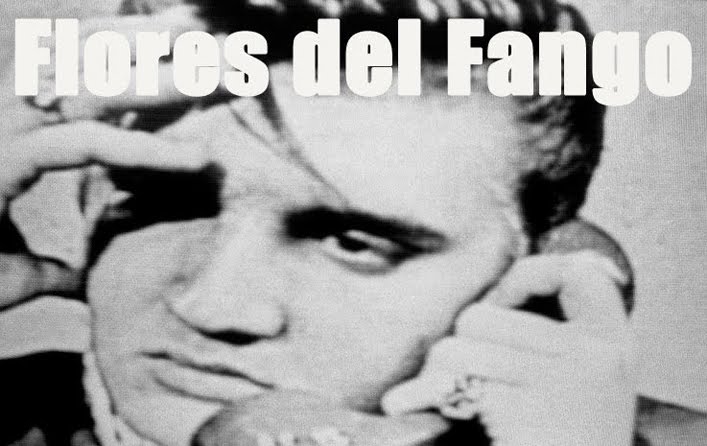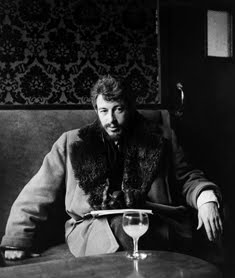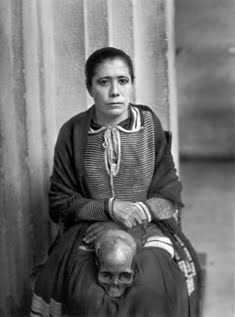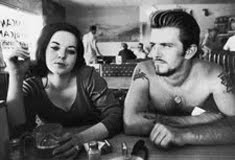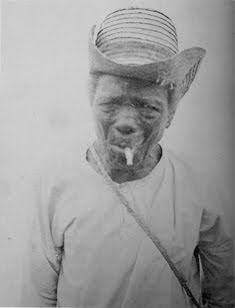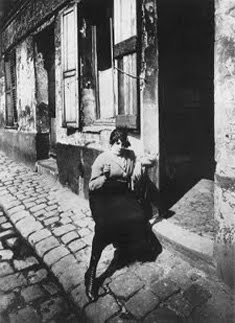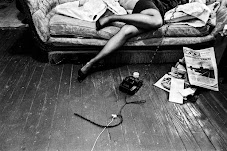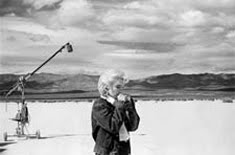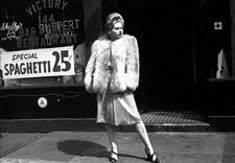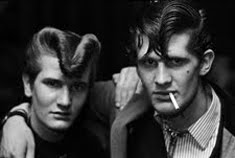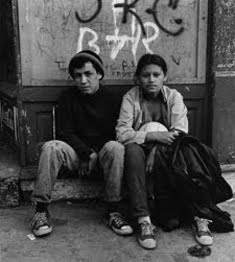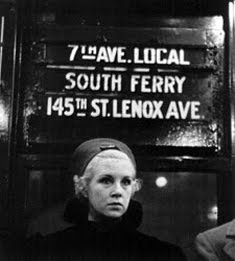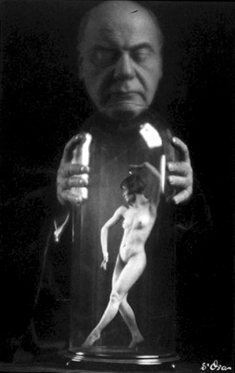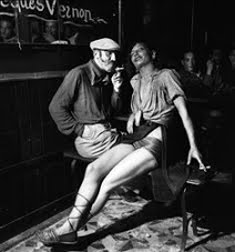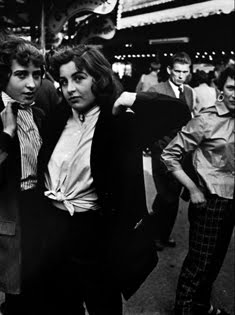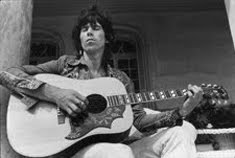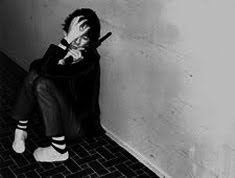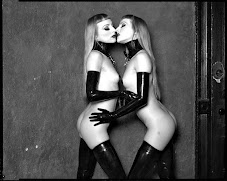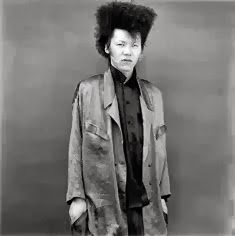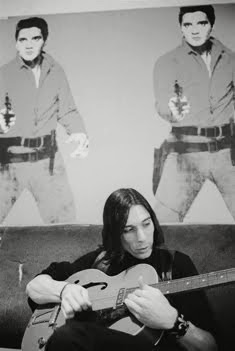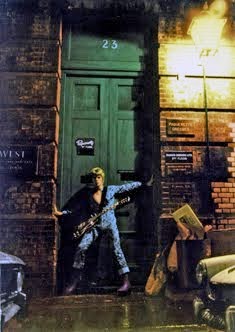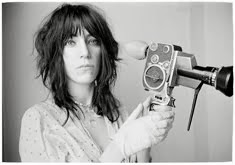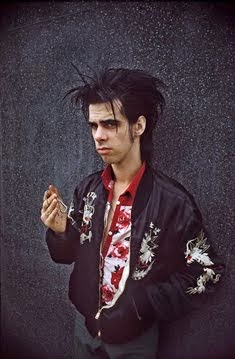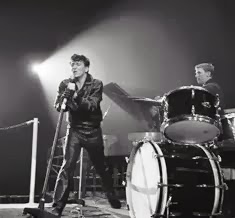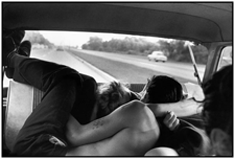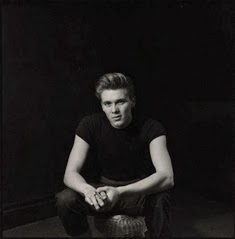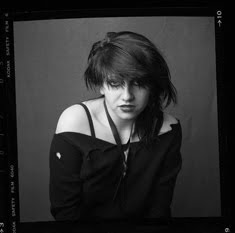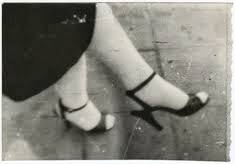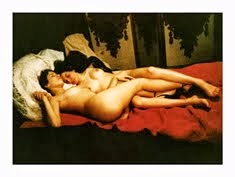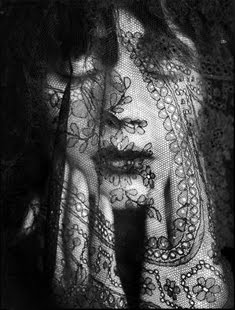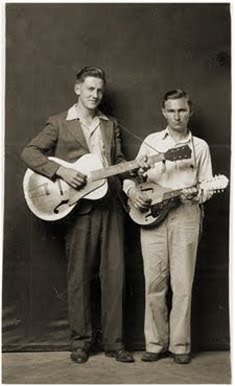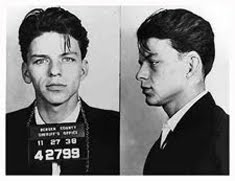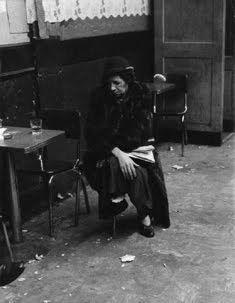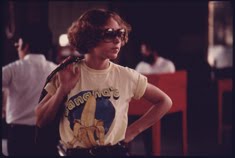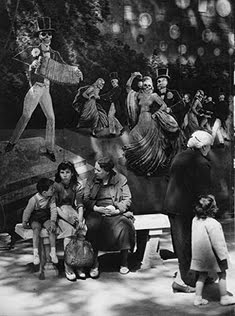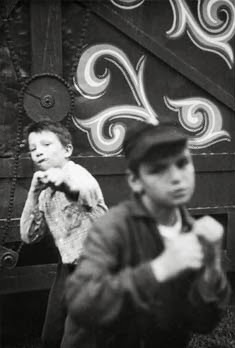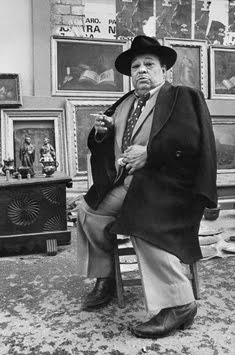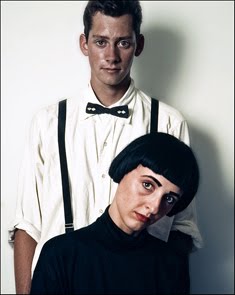Contacté con la fotógrafa Angélica Escoto a través de una primera referencia aquí en el blog y surgió la oportunidad de tener una "conversación" por correo electrónico sobre su trabajo. Así que aquí está. Se agradece comprobar como sus vivencias y situaciones han permitido que unas preguntas torpes y hechas sin el tiempo ni la dedicación que el asunto merece (obligaciones y circunstancias de la vida por medio) desvelen algunos de los sentimientos y escenarios en juego cuando la autora realiza su trabajo, que en definitiva era el objetivo del cuestionario, revelar algo del misterio de esa imagen muda que es siempre una fotografía. Puñaladas traperas es el título de esta casi inexistente sección porque, aunque mal dadas las punzadas, igualmente buscan hacer brotar al autor, que mane un poco de aquello que impregna su trabajo. La sangre del poeta, que diría Cocteau. Un poco traicionero, porque parte del patrimonio de un artista es el misterio. Pues eso, ahí lo dejo. Gracias Angélica.
FdF: Al igual que los acantilados producen una sensación immediata de confín del mundo el desierto provoca, y es parte de lo que me fascina de ellos además de la casi evidente desolación o el efecto de evasión, una especie de dualidad, por un lado como un enfrentamiento con la pura realidad de la Tierra, un erial en su expresión más extensa, y por otro lado esa percepción de paisaje onírico (especialmente cuando hay agua a la vista). Incluso la figura humana puede antojarse fantasmal. En tu trabajo muestras la costumbre de fotografiar en ese marco de tierra semi-desnuda y con poco ornamento, en lo que parece de alguna forma como una ceremonia de encuentro y unión con la brutal belleza de esos parajes. Me gustaría que me contaras un poco cuál es la motivación para que hayas convertido la visita al desierto en una especie de ritual personal, familiar y fotográfico.

Angélica: Desde niña me aterraba verme en un espacio cerrado. En un mundo de 50 kilómetos cuadrados. Aún sin dinero empezamos a acampar mi esposo, mi dos hijas y yo cerca de el mar, pero lejos de la casa, seis horas, luego fueron ocho, luego diez, y así, cada vez quisimos estar más lejos de lugares habitados o poblados, y así encontramos Bahía de los Angeles y ese lugar se convirtió en un refugio, y es que no es para menos, es un paraíso poco conocido, poco visitado. Con el tiempo fui editando el trabajo que tomaba por instinto, por sorpresa y no fue hasta diez años después que me di cuenta que el desierto y el mar eran mi elección y lección de vida.
Cuando voy a Bahía de los Angeles, que es tres o cuatro veces por año no más de siete días, llevo desde hace cuatro años alguna idea para trabajar, en algunos temas madrugo para logralo, casi siempre es cuando me hago mis autorretratos, hay un acto casual en las poses, y en otros temas dejo que los paseos con mis hijas, amigas y familia sea el acto para buscar la foto. A veces espero el momento, a veces lo busco, a veces lo encuentro, a veces no sucede o no sale, pero casi siempre los resultados son un conjunto de situaciones que me provocan una adicción para no parar de hacerlo
 Me gustaría saber, si eso es posible, sobre la banda sonora de esos viajes en familia, la música y sonidos en el coche o en los sitios de parada que quieras recordar.
Me gustaría saber, si eso es posible, sobre la banda sonora de esos viajes en familia, la música y sonidos en el coche o en los sitios de parada que quieras recordar.
El silbido del viento por las noches, el cascabel de las serpientes cuando paramos a la orilla de la carretera, el olor del mar, las algas, los calamares o ballenas varados, el crujir de la arena en la comida, el splash de los delfines por las mañanas, la risa de las gaviotas cuando te acercas a ellas. El sonido de la arena. El olor putrefacto de los manglares.
Cuáles son las reacciones de los niños en ese paisaje.
Mis hijas casi nacieron en el desierto-mar, pero mi sobrino ( mi modelo) cuando fue la primera vez me dijo: “Me siento un enanito en este lugar”. Se maravillan del cielo por las noches, de las islas, de los delfines, de las ballenas, de los lobos marinos, de las mantarrayas. Mis hijas defienden la vida de cada animal, se ponen locas si alguien (invitados) quieren matar una araña o un alacrán y les encanta darles de comer a las hormigas y observarlas como se llevan las comida.
La fauna y flora en ese espacio, que a tí te gusta retratar, transmiten de alguna forma esa sensación de que se trata de supervivientes o víctimas, crecidos o vencidos en condiciones extremas, y además, aún incluso recientes, siempre tienen un aspecto como de rastros primitivos. Y por ahí que veo una conexión con tus fotos de ropa para la serie Walk In Closet, que a mí me transmiten cierto componente de antropología contemporánea. La ropa, además de transmitir identidad y cultura incluso aunque descuides esa faceta, es una huella inequívoca de cada sociedad. Y el armario un bastión de la intimidad, nuestra trastienda, parte de eso a lo que sólo suelen tener acceso nuestros elegidos. Y al mismo tiempo en él atesoramos y con él nos solemos afirmar diariamente. Igualmente la ropa puede ser, obviando la economía de cada cual, un conflicto entre lo que somos y cómo nos presentamos. O entre la sociedad y uno como individuo. O entre lo que se te oferta y lo que se desea transmitir.
 Hace algunos años me conflictuaba pensar que me catalogaran como fotógrafa sosa de cáctus exóticos. Pero mi producción empezó a tener forma con ese trabajo. Aunque mis autorretratos son más antiguos como el del cangrejo, creo que fue el primer autorretrato que me hice cuando conocí la península de BC en 1991, mi amiga nativa del lugar lo tenía en su jardín, arriba de un árbol, yo no podía creer que su hermano, un pescador, lo hubiera encontrado, no quería olvidarlo, jamás.
Hace algunos años me conflictuaba pensar que me catalogaran como fotógrafa sosa de cáctus exóticos. Pero mi producción empezó a tener forma con ese trabajo. Aunque mis autorretratos son más antiguos como el del cangrejo, creo que fue el primer autorretrato que me hice cuando conocí la península de BC en 1991, mi amiga nativa del lugar lo tenía en su jardín, arriba de un árbol, yo no podía creer que su hermano, un pescador, lo hubiera encontrado, no quería olvidarlo, jamás.
Cuéntame un poco, lo que se te antoje, del viaje afuera de la Península de Baja California [Estado mejicano que limita con EE.UU], frontera mediante, que por lo que deduzco, es algo más o menos habitual para tí.
El contraste entre los dos países es trágico, morboso, y deprimente. La frontera es un muro de metal que se inicia desde el mar en el Pacífico hasta el desierto en las montañas de Tecate, que es ahora por donde se aventuran los migrantes para cruzar. En la ciudad hay unas zonas donde construyeron más de dos muros, con alambre de púas que quienes se han colgado de ellos, dicen con los dedos cortados que no son púas sino navajas.
 Las garitas son más de 20, las colas son de más de 400 carros, y la peatonal de 300 a mil personas formadas para cruzar depende del día, la hora y las noticias que afecten la seguridad de los gringos.
Las garitas son más de 20, las colas son de más de 400 carros, y la peatonal de 300 a mil personas formadas para cruzar depende del día, la hora y las noticias que afecten la seguridad de los gringos.
Yo cruzo todos los días para llevar a mis hijas a la escuela. Todos nos formamos con miedo, porque igual no te preguntan más que “Qué lleva y a dónde va” o les da por la lenta revisión secundaria, donde te revisan el carro de Pe a Pa… De tres a media hora para cruzar. Y de regreso, otra aventura, la garita mexicana, con sus semáforos para que no pases material prohibido de Estados Unidos hacia México, aunque los gringos son más estrictos en cuanto a reglas de higiene agropecuarias, llevar un durazno, naranja, o carne de puerco aún cocinada te puede costar perder los papeles. Es un gueto.
En tus autorretratos, además de misterio y juego, parece adivinarse un sutil deseo de evasión, lo que de alguna forma los conectaría con la magia del desierto. O al menos a mí me transmiten eso. Pero al mismo tiempo hay algo de crudeza poética. Qué intenciones básicas y qué motivaciones metáforicas te bullen en la cabeza en el momento de posar.
Evasión o encuentros en un desierto que crecen en mi yo interior, es una analogía. Es una puesta en escena donde represento a cualquier mujer, dejo de ser yo. Mi instinto: hay una necedad necesaria por construir imágenes. Es una terapia, trabajo el pensamiento, lo que me lastima y daña en ese momento.
¿Qué te gusta del acto fotográfico, de la acción de tomar imágenes?
 El juego, la sorpresa, la intuición, el azar y la fantasía. Reflexiono la luz, la perspectiva, el espacio. La osadía de hacer la toma como si fuera la última vez o la última oportunidad.
El juego, la sorpresa, la intuición, el azar y la fantasía. Reflexiono la luz, la perspectiva, el espacio. La osadía de hacer la toma como si fuera la última vez o la última oportunidad.
Como espectadora qué trabajos suelen interesarte, si es que hay algo común en ellos que crees suele captar tu atención y que quieras comentar. Y por qué obras, autores, formato o disciplina sientes especial predilección.
Bueno yo siempre he trabajado con el formato de 35 mm para el desierto. El trabajo de la Walk In Closet es en formato mediano, fue toda una aventura, otra reflexión con la toma, y el pensamiento. Creo no dejaría estos dos formatos nunca. Aunque trabaje para vivir con lo digital, que esa es otra historia, tengo otro proyecto, hago las fiestas de los migrantes mexicanos en San Diego. Más adelante tendré el temple para editarlo y presentarlo.
Mis autores son muchos. Como Ryan McGinley, Jhon Divola, Oliver Chanarin, Alejandra Sanguinetti, Esteban Pastorino, etc., etc.
Parece que en tu trabajo hay también mucha influencia literaria. ¿Quieres comentar algo a este respecto?
 A los trece años me sumergí en la literatura, Tom Sawyer de Mark Twain fue mi primera lectura, y de ahí no paré: Las Mil Y Una Noches, El Quijote, Mujercitas (jajaja), Edgar Allan Poe… clásicos del siglo XIX, Balzac, Flaubert, Dostoyeski, Sholojov, Alejandro Dumas y otros que olvido. Contemporáneos latinoamericanos, Carlos Fuentes, García Marquez, Onetti, Azuela, Juan Rulfo, Juan de la Cabada, Benedetti, Leon Bloy. Cortázar es mi fantasía erótica, Borges, mi preferido, sus cuentos los llevo en mi cerebro todo el tiempo. Releo y releo y sigo gozándolos. Otro que casi está destrozado de tanto subrayarlo es las Ciudades Invisibles de Italo Calvino, Memorias de Adriano,.. Y bueno de ahí muchos más como el Cuarteto de Alenjandría de Lawrence Durrell, Tolkien me provoca envidia, etc, etc, etc. Y mis azotes internos: Silvia Plath y Rosario Castellanos…
A los trece años me sumergí en la literatura, Tom Sawyer de Mark Twain fue mi primera lectura, y de ahí no paré: Las Mil Y Una Noches, El Quijote, Mujercitas (jajaja), Edgar Allan Poe… clásicos del siglo XIX, Balzac, Flaubert, Dostoyeski, Sholojov, Alejandro Dumas y otros que olvido. Contemporáneos latinoamericanos, Carlos Fuentes, García Marquez, Onetti, Azuela, Juan Rulfo, Juan de la Cabada, Benedetti, Leon Bloy. Cortázar es mi fantasía erótica, Borges, mi preferido, sus cuentos los llevo en mi cerebro todo el tiempo. Releo y releo y sigo gozándolos. Otro que casi está destrozado de tanto subrayarlo es las Ciudades Invisibles de Italo Calvino, Memorias de Adriano,.. Y bueno de ahí muchos más como el Cuarteto de Alenjandría de Lawrence Durrell, Tolkien me provoca envidia, etc, etc, etc. Y mis azotes internos: Silvia Plath y Rosario Castellanos…
¿Tienes algo en la cabeza que te interese fotografiar en el futuro?
Los yacimientos de sal en la Península de BC, es un paisaje deslumbrante. He empezado un trabajo que se llama Desierto De Sal, ya tengo algunas fotos. En la ciudad estoy estructurando en mi cerebro (sin hacer una sola imagen). Es un seguimiento de la ropa, pero ahora estudio la forma de hacer esculturas con ellas, intervenir los objetos. Hacer del consumismo un trabajo poético. Me falta aterrizar la idea, pero no llevo prisa.
PUÑALADAS FINALES (MINI-CUESTIONARIO):
Encuentras inspiración diaria en...
Saber que voy a desaparecer pero que tengo la oportunidad de poner a trabajar mi cerebro todos los días para ver cosas extraordinarias. Eso me inspira.
Sitio favorito en el mundo:
Bahía de los Angeles, BC, México.
¿En qué te sueles fijar caminando por la calle?:
En todo, mi mirada y pensamiento son obicuos.
Alguien que te haya marcado en la vida:
Hay muchas personas, yo me enamoro de todos y todas. Y más si son sensibles e inteligentes.
Discos favoritos de todos los tiempos:
Me encanta la ópera, toda. Pero Ennio Morricone es una inspiración para mí. Calidad, belleza e ingenio, no me canso de escucharlo.
Un sitio en la red que visites a menudo o te gustaría recomendar...
Las flores del fango.
¿Algún artista que hayas descubierto en la red y quieras destacar?:
Esteban Pastorino.
Qué hay en tus bolsillos...
Mis visas para cruzar a Estados Unidos, las cuido más que a mí misma.
Un sitio que te gustaría visitar...
Los cenotes sagrados de Quintana Roo, México.
Un sitio para comer y un sitio para beber...
Cervecería artesana el Mamut. Tijuana, BC.
Larga y buena vida, Angélica. Y suerte con todo lo tuyo.
Backstabbing # 2: Angélica Escoto
I contacted photographer Angelica Escoto through a first reference here on the blog and we agreed to have a "conversation" via email about her work. Grateful to see how her experiences and situations have uplifted a bunch of clumsy questions I got to figure out without the time and dedication it deserves (trials and tribulations of life in between), enriched this thing by the feelings and circumstances of the author while doing her job, which ultimately was the objective of the questionnaire, and that is to reveal a little of the mystery of the mute image which is always a photograph. This almost non-existent section is called backstabbing because, although inelegant and inept enough on my way, it seeks to sprout something out of the author, to mane a little of that which permeates the work. The blood of the poet, as Cocteau would say. A bit treacherous because one of the assets of an artist is mystery. So here it is. Thanks Angelica.
FdF: Like cliffs feel straightaway as some sort of end of a world, the desert causes, and is part of what fascinates me about them besides the almost obvious distress or avoidance effect, a kind of duality, first as a confrontation with the stark reality of the Earth, a wasteland in its rawest and extensive expression, and secondly that perception of dreamscape (especially when there is water in sight). Even the human figure may seem to be ghostly there. In your work you show the habit of shooting in that landscape of bare ground with little ornament, in what looks somewhat like a ceremony of encounter and union with the brutal beauty of those places. I'd like to hear what is the motivation for a visit that have turned into a kind of personal, family and photographic ritual.

Angelica: As a child I was terrified to see me in a closed space. In a world of 30 square miles. Even without money my husband, my two daughters and I started camping near the sea but away from home, six hours, then it were eight, then ten, and so each time we wanted to be further away from dwellings or villages, and we found Bahía de los Angeles and this place became a refuge, and it is no wonder, it is a paradise little known, rarely visited. Eventually I was editing the work instinctively took by surprise and it was not until ten years later that I realized that the desert and the sea were my choice and life lesson.
When I go to Bahia de los Angeles, which is three or four times a year no more than seven days, any idea takes four years to work in, sometimes I wake up early to work, it is usually when I do my self-portraits, there is a casualty act in poses, and other issues I leave walking with my daughters, friends and family to be the road to find the picture. Sometimes I wait for the moment, sometimes I look for it, sometimes it does not happen or it does come out, but often the results are a set of situations that cause me an addiction from wich there is no stop.
I wonder on the soundtrack of those family trips, music and sounds in the car or stopping places you want to remember.

The whistling of the wind at night, the rattle snakes when we stop at the side of the road, the smell of the sea, seaweed, squid or beached whales, the crunch of sand in the food, dolphins splashes in the morning, laughing gulls when you approach them. The sound of the sand. The putrid smell of mangroves.
What are the reactions of children in that landscape.
My daughters were born almost in the desert-sea, but my nephew (my model) the first time he went there he said: "I feel like a dwarf in this place." They marvel at the sky at night, the islands, dolphins, whales, sea lions, stingrays. My daughters defend the life of every animal, get mad if someone (guests) want to kill a spider or a scorpion and love to feed the ants and observe them carrying the food.
The wildlife in this area, that you like to portray yourself, somehow transmit a feeling of survivors or victims, grown up or decesead in extreme conditions, and although it is not the case, always have that look of primitive trails. And there I see a connection with your photos of clothes for the Walk In Closet series, which to me convey certain component of contemporary anthropology. The clothes, in addition to transmitting identity and culture even when the aspect is neglected, it is a clear fingerprint of each society. And the closet a bastion of privacy, our backroom, part of what we only give access to our elected. And we treasure in it and we usually confirm ourselves daily. Clothing can also be, ignoring the economy of each one, a conflict between what we are and how we present ourselves. Or between society and one as an individual. Or between what you are offered and what you want to communicate.

Some years ago I was in a conflic with a fear of being cataloged as a bland photographer of exotic cactus. But my production began to take shape with that work. Although my self-portraits are older like the one with the crab, I think it was the first self-portrait I did when I knew the peninsula of BC in 1991, a friend of my native place had it in his garden, up a tree, I could not believe that her brother a fisherman would have found it, I didn't want to forget it, ever.
Tell me a little, whatever you want to share, of that travel, the border halfway, outside Baja California [Mexican Estate limiting with U.S.A.], wich for what I gather, is more or less a regular basis for you.
The contrast between these two countries is tragic, morbid and depressing. The border is a metal wall that starts from the sea in the Pacific to the desert in the mountains of Tecate, where migrants now venture to cross. In the city there are areas where they built more than two walls, barbed wire and whoever have jumped them say with severed fingers that those are like barbed blades.
The booths are over 20, the car lines consist of more than 400 cars, and pedestrians lines count from 300 to thousand people trained to cross depending on the day, time and news affecting the safety of gringos.

I cross every day to take my daughters to school. We are all scared, they can ask just a simple "What do you carry and where do you go" or slow you down for a secondary inspection, where they check the whole of the car... Three to half an hour to cross. And back there, another adventure, the Mexican booth, with its traffic lights for not passing banned stuff from the U.S. to Mexico, although the Americans have stricter rules regarding agricultural hygiene, carrying peaches, oranges, or cooked pork can cost you to lose the papers. It's a ghetto.
In your self-portraits, in addition to mystery and game I guess a subtle desire to escape, which could somehow connect with the magic of the desert. Or at least to me it conveys that. But at the same time there is some poetic rawness. What basic intentions and metaphorical motivations do you have in your head at the time of posing?.

Escape to or encounters in the desert growing in my inner self, it's an analogy. It is a stage where I represent any woman, I stop being me. My instinct is a necessary folly to build images. It is a therapy, I work the thoughts that pity me and are damaging me at the time.
What do you like of the photographic act, the act of taking pictures?
The game, surprise, intuition, chance and fantasy. Reflection about light, perspective, space. The audacity to make the decision as if it was the last time or last chance.
As a spectator what interests you, if there is something common in that you think tends to take your attention and you want to comment. And what works, authors, formats or discipline you feel special predilection for.
Well I always work with the format of 35 mm for the desert. The work of the Walk In Closet is in medium format, it was an adventure, taking another reflection and thought. I would not leave any of these two formats ever. Although I work for a living with digital, but that's another story. I have another project, I do parties of Mexican migrants in San Diego, wich in the future I will take the time to edit and submit.
My authors are many. Such as Ryan McGinley, John Divola, Oliver Chanarin, Alejandra Sanguinetti, Esteban Pastorino, etc., etc..
It seems that there are also many literary influences in your work. Want to say something about this?
At thirteen I immersed myself in literature, Tom Sawyer by Mark Twain was my first reading, and then on I did not stop: The Arabian Nights, Don Quixote, Little Women (lol), Edgar Allan Poe ... classic nineteenth century, Balzac, Flaubert, Dostoyeski, Sholokhov, Alexander Dumas and others I forget. Latin American contemporaries, Carlos Fuentes, Garcia Marquez, Onetti, Azuela, Juan Rulfo,
Juan de la Cabada, Benedetti, Leon Bloy. Cortázar is my erotic fantasy, Borges, my favorite, his short stories I have them in my brain all the time. I reread and reread and still enjoy them. Another one that is almost destroyed by underlining it is Invisible Cities by Italo Calvino, Memoirs of Hadrian,... Well there are many more like The Alexandria Quartet by Lawrence Durrell, Tolkien makes me envy, etc, etc, etc.. And for my inner lashing Silvia Plath and Rosario Castellanos...
Have something in mind that you want to shoot in the future?
The salt deposits in the Peninsula of BC, is a dazzling landscape. I started a series that is called Salt Desert, I already have some pictures. In the city I am structuring my brain (without making a single image). It is a follow-up of the clothes, but now a study on how to make sculptures with them, intervening objects. As a poetic work on consumerism. I need to land the idea, not rushing.
FINAL STABS (MINI-QUIZ):
Find daily inspiration in...
Knowing that I will disappear but I have the chance to put my brain to work every day to see extraordinary things. That inspires me.
Favorite place in the world:
Bahia de los Angeles, BC, Mexico.
What usually calls your attention while walking down the street?:
Everything, my eyes and thoughts are obicuos.
Someone who has influenced you in life:
There are plenty, I fall in love with everyone. Especially if they are sensitive and intelligent.
Favorite albums of all time:
I love the opera, all. But Ennio Morricone is an isnpiration to me. Quality, beauty and wit, I never tire of listening to his music.
A web site that you visit often or would like to recommend...
Las flores del fango.
Any artist you've found on the net and want to highlight?:
Esteban Pastorino.
What's in your pockets...
My visas to cross into the United States, I care more about them than I care about myself.
A place that you want to visit...
Sacred Cenotes in Quintana Roo, Mexico.
A place to eat and a place to drink...
Mamut craft brewery. Tijuana, BC.
Long and good life, Angelica. And good luck with all your things.
> http://www.angelicaescotophoto.com

Mira tambiénRead also
>Varias Puñaladas Traperas # 1: David Arnoff
FdF: Al igual que los acantilados producen una sensación immediata de confín del mundo el desierto provoca, y es parte de lo que me fascina de ellos además de la casi evidente desolación o el efecto de evasión, una especie de dualidad, por un lado como un enfrentamiento con la pura realidad de la Tierra, un erial en su expresión más extensa, y por otro lado esa percepción de paisaje onírico (especialmente cuando hay agua a la vista). Incluso la figura humana puede antojarse fantasmal. En tu trabajo muestras la costumbre de fotografiar en ese marco de tierra semi-desnuda y con poco ornamento, en lo que parece de alguna forma como una ceremonia de encuentro y unión con la brutal belleza de esos parajes. Me gustaría que me contaras un poco cuál es la motivación para que hayas convertido la visita al desierto en una especie de ritual personal, familiar y fotográfico.

Angélica: Desde niña me aterraba verme en un espacio cerrado. En un mundo de 50 kilómetos cuadrados. Aún sin dinero empezamos a acampar mi esposo, mi dos hijas y yo cerca de el mar, pero lejos de la casa, seis horas, luego fueron ocho, luego diez, y así, cada vez quisimos estar más lejos de lugares habitados o poblados, y así encontramos Bahía de los Angeles y ese lugar se convirtió en un refugio, y es que no es para menos, es un paraíso poco conocido, poco visitado. Con el tiempo fui editando el trabajo que tomaba por instinto, por sorpresa y no fue hasta diez años después que me di cuenta que el desierto y el mar eran mi elección y lección de vida.
Cuando voy a Bahía de los Angeles, que es tres o cuatro veces por año no más de siete días, llevo desde hace cuatro años alguna idea para trabajar, en algunos temas madrugo para logralo, casi siempre es cuando me hago mis autorretratos, hay un acto casual en las poses, y en otros temas dejo que los paseos con mis hijas, amigas y familia sea el acto para buscar la foto. A veces espero el momento, a veces lo busco, a veces lo encuentro, a veces no sucede o no sale, pero casi siempre los resultados son un conjunto de situaciones que me provocan una adicción para no parar de hacerlo
 Me gustaría saber, si eso es posible, sobre la banda sonora de esos viajes en familia, la música y sonidos en el coche o en los sitios de parada que quieras recordar.
Me gustaría saber, si eso es posible, sobre la banda sonora de esos viajes en familia, la música y sonidos en el coche o en los sitios de parada que quieras recordar.El silbido del viento por las noches, el cascabel de las serpientes cuando paramos a la orilla de la carretera, el olor del mar, las algas, los calamares o ballenas varados, el crujir de la arena en la comida, el splash de los delfines por las mañanas, la risa de las gaviotas cuando te acercas a ellas. El sonido de la arena. El olor putrefacto de los manglares.
Cuáles son las reacciones de los niños en ese paisaje.
Mis hijas casi nacieron en el desierto-mar, pero mi sobrino ( mi modelo) cuando fue la primera vez me dijo: “Me siento un enanito en este lugar”. Se maravillan del cielo por las noches, de las islas, de los delfines, de las ballenas, de los lobos marinos, de las mantarrayas. Mis hijas defienden la vida de cada animal, se ponen locas si alguien (invitados) quieren matar una araña o un alacrán y les encanta darles de comer a las hormigas y observarlas como se llevan las comida.
La fauna y flora en ese espacio, que a tí te gusta retratar, transmiten de alguna forma esa sensación de que se trata de supervivientes o víctimas, crecidos o vencidos en condiciones extremas, y además, aún incluso recientes, siempre tienen un aspecto como de rastros primitivos. Y por ahí que veo una conexión con tus fotos de ropa para la serie Walk In Closet, que a mí me transmiten cierto componente de antropología contemporánea. La ropa, además de transmitir identidad y cultura incluso aunque descuides esa faceta, es una huella inequívoca de cada sociedad. Y el armario un bastión de la intimidad, nuestra trastienda, parte de eso a lo que sólo suelen tener acceso nuestros elegidos. Y al mismo tiempo en él atesoramos y con él nos solemos afirmar diariamente. Igualmente la ropa puede ser, obviando la economía de cada cual, un conflicto entre lo que somos y cómo nos presentamos. O entre la sociedad y uno como individuo. O entre lo que se te oferta y lo que se desea transmitir.
 Hace algunos años me conflictuaba pensar que me catalogaran como fotógrafa sosa de cáctus exóticos. Pero mi producción empezó a tener forma con ese trabajo. Aunque mis autorretratos son más antiguos como el del cangrejo, creo que fue el primer autorretrato que me hice cuando conocí la península de BC en 1991, mi amiga nativa del lugar lo tenía en su jardín, arriba de un árbol, yo no podía creer que su hermano, un pescador, lo hubiera encontrado, no quería olvidarlo, jamás.
Hace algunos años me conflictuaba pensar que me catalogaran como fotógrafa sosa de cáctus exóticos. Pero mi producción empezó a tener forma con ese trabajo. Aunque mis autorretratos son más antiguos como el del cangrejo, creo que fue el primer autorretrato que me hice cuando conocí la península de BC en 1991, mi amiga nativa del lugar lo tenía en su jardín, arriba de un árbol, yo no podía creer que su hermano, un pescador, lo hubiera encontrado, no quería olvidarlo, jamás.Cuéntame un poco, lo que se te antoje, del viaje afuera de la Península de Baja California [Estado mejicano que limita con EE.UU], frontera mediante, que por lo que deduzco, es algo más o menos habitual para tí.
El contraste entre los dos países es trágico, morboso, y deprimente. La frontera es un muro de metal que se inicia desde el mar en el Pacífico hasta el desierto en las montañas de Tecate, que es ahora por donde se aventuran los migrantes para cruzar. En la ciudad hay unas zonas donde construyeron más de dos muros, con alambre de púas que quienes se han colgado de ellos, dicen con los dedos cortados que no son púas sino navajas.
 Las garitas son más de 20, las colas son de más de 400 carros, y la peatonal de 300 a mil personas formadas para cruzar depende del día, la hora y las noticias que afecten la seguridad de los gringos.
Las garitas son más de 20, las colas son de más de 400 carros, y la peatonal de 300 a mil personas formadas para cruzar depende del día, la hora y las noticias que afecten la seguridad de los gringos.Yo cruzo todos los días para llevar a mis hijas a la escuela. Todos nos formamos con miedo, porque igual no te preguntan más que “Qué lleva y a dónde va” o les da por la lenta revisión secundaria, donde te revisan el carro de Pe a Pa… De tres a media hora para cruzar. Y de regreso, otra aventura, la garita mexicana, con sus semáforos para que no pases material prohibido de Estados Unidos hacia México, aunque los gringos son más estrictos en cuanto a reglas de higiene agropecuarias, llevar un durazno, naranja, o carne de puerco aún cocinada te puede costar perder los papeles. Es un gueto.
En tus autorretratos, además de misterio y juego, parece adivinarse un sutil deseo de evasión, lo que de alguna forma los conectaría con la magia del desierto. O al menos a mí me transmiten eso. Pero al mismo tiempo hay algo de crudeza poética. Qué intenciones básicas y qué motivaciones metáforicas te bullen en la cabeza en el momento de posar.
Evasión o encuentros en un desierto que crecen en mi yo interior, es una analogía. Es una puesta en escena donde represento a cualquier mujer, dejo de ser yo. Mi instinto: hay una necedad necesaria por construir imágenes. Es una terapia, trabajo el pensamiento, lo que me lastima y daña en ese momento.
¿Qué te gusta del acto fotográfico, de la acción de tomar imágenes?
 El juego, la sorpresa, la intuición, el azar y la fantasía. Reflexiono la luz, la perspectiva, el espacio. La osadía de hacer la toma como si fuera la última vez o la última oportunidad.
El juego, la sorpresa, la intuición, el azar y la fantasía. Reflexiono la luz, la perspectiva, el espacio. La osadía de hacer la toma como si fuera la última vez o la última oportunidad.Como espectadora qué trabajos suelen interesarte, si es que hay algo común en ellos que crees suele captar tu atención y que quieras comentar. Y por qué obras, autores, formato o disciplina sientes especial predilección.
Bueno yo siempre he trabajado con el formato de 35 mm para el desierto. El trabajo de la Walk In Closet es en formato mediano, fue toda una aventura, otra reflexión con la toma, y el pensamiento. Creo no dejaría estos dos formatos nunca. Aunque trabaje para vivir con lo digital, que esa es otra historia, tengo otro proyecto, hago las fiestas de los migrantes mexicanos en San Diego. Más adelante tendré el temple para editarlo y presentarlo.
Mis autores son muchos. Como Ryan McGinley, Jhon Divola, Oliver Chanarin, Alejandra Sanguinetti, Esteban Pastorino, etc., etc.
Parece que en tu trabajo hay también mucha influencia literaria. ¿Quieres comentar algo a este respecto?
 A los trece años me sumergí en la literatura, Tom Sawyer de Mark Twain fue mi primera lectura, y de ahí no paré: Las Mil Y Una Noches, El Quijote, Mujercitas (jajaja), Edgar Allan Poe… clásicos del siglo XIX, Balzac, Flaubert, Dostoyeski, Sholojov, Alejandro Dumas y otros que olvido. Contemporáneos latinoamericanos, Carlos Fuentes, García Marquez, Onetti, Azuela, Juan Rulfo, Juan de la Cabada, Benedetti, Leon Bloy. Cortázar es mi fantasía erótica, Borges, mi preferido, sus cuentos los llevo en mi cerebro todo el tiempo. Releo y releo y sigo gozándolos. Otro que casi está destrozado de tanto subrayarlo es las Ciudades Invisibles de Italo Calvino, Memorias de Adriano,.. Y bueno de ahí muchos más como el Cuarteto de Alenjandría de Lawrence Durrell, Tolkien me provoca envidia, etc, etc, etc. Y mis azotes internos: Silvia Plath y Rosario Castellanos…
A los trece años me sumergí en la literatura, Tom Sawyer de Mark Twain fue mi primera lectura, y de ahí no paré: Las Mil Y Una Noches, El Quijote, Mujercitas (jajaja), Edgar Allan Poe… clásicos del siglo XIX, Balzac, Flaubert, Dostoyeski, Sholojov, Alejandro Dumas y otros que olvido. Contemporáneos latinoamericanos, Carlos Fuentes, García Marquez, Onetti, Azuela, Juan Rulfo, Juan de la Cabada, Benedetti, Leon Bloy. Cortázar es mi fantasía erótica, Borges, mi preferido, sus cuentos los llevo en mi cerebro todo el tiempo. Releo y releo y sigo gozándolos. Otro que casi está destrozado de tanto subrayarlo es las Ciudades Invisibles de Italo Calvino, Memorias de Adriano,.. Y bueno de ahí muchos más como el Cuarteto de Alenjandría de Lawrence Durrell, Tolkien me provoca envidia, etc, etc, etc. Y mis azotes internos: Silvia Plath y Rosario Castellanos…¿Tienes algo en la cabeza que te interese fotografiar en el futuro?
Los yacimientos de sal en la Península de BC, es un paisaje deslumbrante. He empezado un trabajo que se llama Desierto De Sal, ya tengo algunas fotos. En la ciudad estoy estructurando en mi cerebro (sin hacer una sola imagen). Es un seguimiento de la ropa, pero ahora estudio la forma de hacer esculturas con ellas, intervenir los objetos. Hacer del consumismo un trabajo poético. Me falta aterrizar la idea, pero no llevo prisa.
PUÑALADAS FINALES (MINI-CUESTIONARIO):
Encuentras inspiración diaria en...
Saber que voy a desaparecer pero que tengo la oportunidad de poner a trabajar mi cerebro todos los días para ver cosas extraordinarias. Eso me inspira.
Sitio favorito en el mundo:
Bahía de los Angeles, BC, México.
¿En qué te sueles fijar caminando por la calle?:
En todo, mi mirada y pensamiento son obicuos.
Alguien que te haya marcado en la vida:
Hay muchas personas, yo me enamoro de todos y todas. Y más si son sensibles e inteligentes.
Discos favoritos de todos los tiempos:
Me encanta la ópera, toda. Pero Ennio Morricone es una inspiración para mí. Calidad, belleza e ingenio, no me canso de escucharlo.
Un sitio en la red que visites a menudo o te gustaría recomendar...
Las flores del fango.
¿Algún artista que hayas descubierto en la red y quieras destacar?:
Esteban Pastorino.
Qué hay en tus bolsillos...
Mis visas para cruzar a Estados Unidos, las cuido más que a mí misma.
Un sitio que te gustaría visitar...
Los cenotes sagrados de Quintana Roo, México.
Un sitio para comer y un sitio para beber...
Cervecería artesana el Mamut. Tijuana, BC.
Larga y buena vida, Angélica. Y suerte con todo lo tuyo.
Backstabbing # 2: Angélica Escoto
I contacted photographer Angelica Escoto through a first reference here on the blog and we agreed to have a "conversation" via email about her work. Grateful to see how her experiences and situations have uplifted a bunch of clumsy questions I got to figure out without the time and dedication it deserves (trials and tribulations of life in between), enriched this thing by the feelings and circumstances of the author while doing her job, which ultimately was the objective of the questionnaire, and that is to reveal a little of the mystery of the mute image which is always a photograph. This almost non-existent section is called backstabbing because, although inelegant and inept enough on my way, it seeks to sprout something out of the author, to mane a little of that which permeates the work. The blood of the poet, as Cocteau would say. A bit treacherous because one of the assets of an artist is mystery. So here it is. Thanks Angelica.
FdF: Like cliffs feel straightaway as some sort of end of a world, the desert causes, and is part of what fascinates me about them besides the almost obvious distress or avoidance effect, a kind of duality, first as a confrontation with the stark reality of the Earth, a wasteland in its rawest and extensive expression, and secondly that perception of dreamscape (especially when there is water in sight). Even the human figure may seem to be ghostly there. In your work you show the habit of shooting in that landscape of bare ground with little ornament, in what looks somewhat like a ceremony of encounter and union with the brutal beauty of those places. I'd like to hear what is the motivation for a visit that have turned into a kind of personal, family and photographic ritual.

Angelica: As a child I was terrified to see me in a closed space. In a world of 30 square miles. Even without money my husband, my two daughters and I started camping near the sea but away from home, six hours, then it were eight, then ten, and so each time we wanted to be further away from dwellings or villages, and we found Bahía de los Angeles and this place became a refuge, and it is no wonder, it is a paradise little known, rarely visited. Eventually I was editing the work instinctively took by surprise and it was not until ten years later that I realized that the desert and the sea were my choice and life lesson.
When I go to Bahia de los Angeles, which is three or four times a year no more than seven days, any idea takes four years to work in, sometimes I wake up early to work, it is usually when I do my self-portraits, there is a casualty act in poses, and other issues I leave walking with my daughters, friends and family to be the road to find the picture. Sometimes I wait for the moment, sometimes I look for it, sometimes it does not happen or it does come out, but often the results are a set of situations that cause me an addiction from wich there is no stop.
I wonder on the soundtrack of those family trips, music and sounds in the car or stopping places you want to remember.

The whistling of the wind at night, the rattle snakes when we stop at the side of the road, the smell of the sea, seaweed, squid or beached whales, the crunch of sand in the food, dolphins splashes in the morning, laughing gulls when you approach them. The sound of the sand. The putrid smell of mangroves.
What are the reactions of children in that landscape.
My daughters were born almost in the desert-sea, but my nephew (my model) the first time he went there he said: "I feel like a dwarf in this place." They marvel at the sky at night, the islands, dolphins, whales, sea lions, stingrays. My daughters defend the life of every animal, get mad if someone (guests) want to kill a spider or a scorpion and love to feed the ants and observe them carrying the food.
The wildlife in this area, that you like to portray yourself, somehow transmit a feeling of survivors or victims, grown up or decesead in extreme conditions, and although it is not the case, always have that look of primitive trails. And there I see a connection with your photos of clothes for the Walk In Closet series, which to me convey certain component of contemporary anthropology. The clothes, in addition to transmitting identity and culture even when the aspect is neglected, it is a clear fingerprint of each society. And the closet a bastion of privacy, our backroom, part of what we only give access to our elected. And we treasure in it and we usually confirm ourselves daily. Clothing can also be, ignoring the economy of each one, a conflict between what we are and how we present ourselves. Or between society and one as an individual. Or between what you are offered and what you want to communicate.

Some years ago I was in a conflic with a fear of being cataloged as a bland photographer of exotic cactus. But my production began to take shape with that work. Although my self-portraits are older like the one with the crab, I think it was the first self-portrait I did when I knew the peninsula of BC in 1991, a friend of my native place had it in his garden, up a tree, I could not believe that her brother a fisherman would have found it, I didn't want to forget it, ever.
Tell me a little, whatever you want to share, of that travel, the border halfway, outside Baja California [Mexican Estate limiting with U.S.A.], wich for what I gather, is more or less a regular basis for you.
The contrast between these two countries is tragic, morbid and depressing. The border is a metal wall that starts from the sea in the Pacific to the desert in the mountains of Tecate, where migrants now venture to cross. In the city there are areas where they built more than two walls, barbed wire and whoever have jumped them say with severed fingers that those are like barbed blades.
The booths are over 20, the car lines consist of more than 400 cars, and pedestrians lines count from 300 to thousand people trained to cross depending on the day, time and news affecting the safety of gringos.

I cross every day to take my daughters to school. We are all scared, they can ask just a simple "What do you carry and where do you go" or slow you down for a secondary inspection, where they check the whole of the car... Three to half an hour to cross. And back there, another adventure, the Mexican booth, with its traffic lights for not passing banned stuff from the U.S. to Mexico, although the Americans have stricter rules regarding agricultural hygiene, carrying peaches, oranges, or cooked pork can cost you to lose the papers. It's a ghetto.
In your self-portraits, in addition to mystery and game I guess a subtle desire to escape, which could somehow connect with the magic of the desert. Or at least to me it conveys that. But at the same time there is some poetic rawness. What basic intentions and metaphorical motivations do you have in your head at the time of posing?.

Escape to or encounters in the desert growing in my inner self, it's an analogy. It is a stage where I represent any woman, I stop being me. My instinct is a necessary folly to build images. It is a therapy, I work the thoughts that pity me and are damaging me at the time.
What do you like of the photographic act, the act of taking pictures?
The game, surprise, intuition, chance and fantasy. Reflection about light, perspective, space. The audacity to make the decision as if it was the last time or last chance.
As a spectator what interests you, if there is something common in that you think tends to take your attention and you want to comment. And what works, authors, formats or discipline you feel special predilection for.
Well I always work with the format of 35 mm for the desert. The work of the Walk In Closet is in medium format, it was an adventure, taking another reflection and thought. I would not leave any of these two formats ever. Although I work for a living with digital, but that's another story. I have another project, I do parties of Mexican migrants in San Diego, wich in the future I will take the time to edit and submit.
My authors are many. Such as Ryan McGinley, John Divola, Oliver Chanarin, Alejandra Sanguinetti, Esteban Pastorino, etc., etc..
It seems that there are also many literary influences in your work. Want to say something about this?
At thirteen I immersed myself in literature, Tom Sawyer by Mark Twain was my first reading, and then on I did not stop: The Arabian Nights, Don Quixote, Little Women (lol), Edgar Allan Poe ... classic nineteenth century, Balzac, Flaubert, Dostoyeski, Sholokhov, Alexander Dumas and others I forget. Latin American contemporaries, Carlos Fuentes, Garcia Marquez, Onetti, Azuela, Juan Rulfo,
Juan de la Cabada, Benedetti, Leon Bloy. Cortázar is my erotic fantasy, Borges, my favorite, his short stories I have them in my brain all the time. I reread and reread and still enjoy them. Another one that is almost destroyed by underlining it is Invisible Cities by Italo Calvino, Memoirs of Hadrian,... Well there are many more like The Alexandria Quartet by Lawrence Durrell, Tolkien makes me envy, etc, etc, etc.. And for my inner lashing Silvia Plath and Rosario Castellanos...
Have something in mind that you want to shoot in the future?
The salt deposits in the Peninsula of BC, is a dazzling landscape. I started a series that is called Salt Desert, I already have some pictures. In the city I am structuring my brain (without making a single image). It is a follow-up of the clothes, but now a study on how to make sculptures with them, intervening objects. As a poetic work on consumerism. I need to land the idea, not rushing.
FINAL STABS (MINI-QUIZ):
Find daily inspiration in...
Knowing that I will disappear but I have the chance to put my brain to work every day to see extraordinary things. That inspires me.
Favorite place in the world:
Bahia de los Angeles, BC, Mexico.
What usually calls your attention while walking down the street?:
Everything, my eyes and thoughts are obicuos.
Someone who has influenced you in life:
There are plenty, I fall in love with everyone. Especially if they are sensitive and intelligent.
Favorite albums of all time:
I love the opera, all. But Ennio Morricone is an isnpiration to me. Quality, beauty and wit, I never tire of listening to his music.
A web site that you visit often or would like to recommend...
Las flores del fango.
Any artist you've found on the net and want to highlight?:
Esteban Pastorino.
What's in your pockets...
My visas to cross into the United States, I care more about them than I care about myself.
A place that you want to visit...
Sacred Cenotes in Quintana Roo, Mexico.
A place to eat and a place to drink...
Mamut craft brewery. Tijuana, BC.
Long and good life, Angelica. And good luck with all your things.
> http://www.angelicaescotophoto.com

Mira tambiénRead also
>Varias Puñaladas Traperas # 1: David Arnoff
